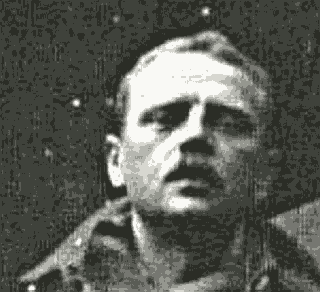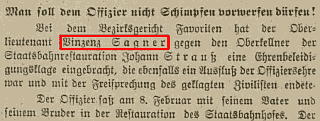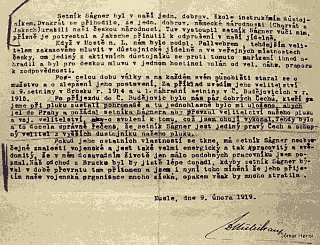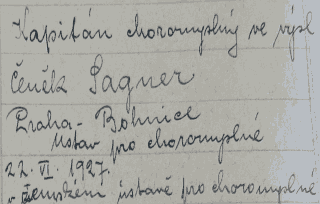
Jan Vaněk was arguably the most obvious of all the prototypes of characters in The Good Soldier Švejk.
The Who's who page on Jaroslav Hašek presents a gallery of persons from real life who to a varying degree are associated with The Good Soldier Švejk and his creator. Several of the characters in the novel are known to be based on real-life people, mostly officers from Infanterieregiment Nr. 91. Some of Hašek's literary figures carry the full names of their model, some are only thinly disguised and some names diverge from that of their "model", but they can be pinpointed by analyzing the circumstances in which they appear.
A handful of "prototypes" are easily recognisable like Rudolf Lukas and Jan Vaněk, others like Zdeněk Matěj Kuděj and Emanuél Michálek are less obvious inspirations. One would also assume that most of these characters borrow traits from more than one person, one such example is Švejk himself.
A far larger number of assumed prototypes are connected to their literary counterparts by little more than the name. Josef Švejk is here the prime example, but Jan Eybl also fits in this category. The list of prototypes only contains those who inspired characters that directly take part in the plot.
Researchers, the so-called Haškologists, are also included on this page but this list is per 15 June 2022 restricted to Radko Pytlík and two important but relatively unknown contributors to our knowledge about Hašek and Švejk. In due course entries on other experts like Václav Menger and Zdena Ančík will be added.
 | Sagner, Čeněk | |||||
| *13.3.1884 Zámrsk - †22.6.1927 Praha-Bohnice | ||||||
| ||||||

Vinzenz Sagner in IR91 during the war. Bestand Rudolf Kießwetter . Kriegsarchiv.
© ÖStA
Sagner was an Austrian (from 1918 Czechoslovak) officer who clearly is the main inspiration for Hašek’s Hauptmann Ságner. He was the author's battalion commander from 11 July to 24 September 1915 (IR. 91, 3rd field battalion) and they both served in Budějovice and Bruck earlier that year.
The author borrowed the name, position in the command hierarchy, and to a degree the rank (Sagner was promoted from senior lieutenant to captain only on 1 September 1915). Otherwise, the literary Hauptmann Ságner and the real Sagner seem to have had little in common, and Sagner was not even the commander of Jaroslav Hašek's march battalion.
Sagner was born in Zámrsk in eastern Bohemia in 1884, the son of railway inspector Jan Sagner and Josefa (born Machačková). The family moved to Prague where they registered with the police on 4 August 1890, resident in Karlín. In 1896 he enrolled at Česká reálka in Ječná ulice in Praha, where he studied 4 years. Incidentally, the school was located in the very neighbourhood where Jaroslav Hašek grew up and studied. He completed his studies in Svitavy, presumably in 1900 and 1901.
On 18 August 1905 he joined the army, after having attended Prager Infanteriekadettenschule from 1901 onwards. He graduated with excellent results and joined Infanterieregiment Nr. 91 immediately after graduation. He was mostly stationed with the III. Feldbataillon in Prague where he also served as instructor at the Reserveoffizierschule. On 1 May 1908 he was promoted to lieutenant and on 1 May 1913 to senior lieutenant.
Otherwise his military service record (Hauptgrundbuchsblatt Nr. 259) reveals that he was 180 cm tall, wore shoe size 10, had blond hair, an oval face, blue eyes, and his civilian status single. He spoke adn wrote Czech and German.
Incident at Staatsbahnhof

, 16.5.1913

, 16.5.1913

, 5.11.1913
On 8 February 1913 Sagner was involved in an incident that later hit the headlines in national newspapers and even reached Reichsrat. Together with his father and brother, he had a dispute with the waiter Johann Strauß in the restaurant at Vienna's Staatsbahnhof. The officer insulted the waiter by calling him a Schweinskopf (pig-head), tried to draw his sabre and finally slapped him in the face. After the incident Sagner took the waiter to court, accusing him of showing disrespect for an officer. The hearing took place in the district court of Favoriten (Vienna) in May and Sagner lost the trial.
That was however not the end of the story. Attorney general Dr Viktor von Hochenburger seemingly intervened in an attempt to influence the course of justice, and this was apparently not the first time the minister had come under scrutiny for such approaches. He had allegedly contacted the judge Dr Ertl and classed the verdict as "tactless". The case escalated and ended in parliament where it was debated in Justizausschuss (justice committee) on 13 November 1913. The case was widely reported and even reached some front pages but most of them didn't mention the officer's name. It is therefore unlikely that Jaroslav Hašek ever connected the court case with his future superior in k.u.k. Heer, otherwise it would no doubt have resulted in a biting anecdote by Einjährigfreiwilliger Marek.
During the war

© VÚA

Gefecthtsbericht, Sokal, 9. August 1915.
© ÖStA
Soon after mobilisation in August 1914, he was sent to the front in Serbia where he took part in fighting until 27 November 1914 when he fell ill. After this followed a period of recuperation and leave. Sagner distinguished himself several times on the Serbian front and was decorated with Signum Laudis on 9 January 1915. On one occasion he even climbed a tree and directed the artillery fire from there, a curious parallel to Oberleutnant Berger in the novel.
During his period of sick leave in Prague, he volunteered as an instructor at the school for one-year volunteers at Infanterieregiment Nr. 11. He started here on 25 January 1915 but from 28 February he was back in service with IR. 91 in Budějovice, as commander of 1. Ersatzkompanie, the company Jaroslav Hašek initially joined. It is overwhelmingly likely that they met already during this period. Sagner took part in the transfer of the regiment’s replacement battalion to Bruck (1 June), but on 14 June 1915, he left for the front in Galicia as Einzelreisender (single traveller), in time to take part in the battles by Grodek and Gniła Lipa. Initially, he served as company commander but on 2 July he assumed command of III. Feldbataillon, a unit that in the preceding battles had been totally decimated. The battalion still had only half its manpower, consisting of the 9th and 10th field company. Only with the arrival of the XII. Marschbataillon by Łonie (ukr. Лоні) on 11 July 1915 did the battalion reach full manpower. It was with this march battalion Hašek arrived at the front, and here he and his fellow soldiers Rudolf Lukas, Jan Vaněk, Hans Bigler, and František Strašlipka joined the 11. Feldkompanie.
Material from VÚA portrays Sagner as ruthless; urging his soldiers to show the enemy (and potentially untrustworthy Galician civilians) no mercy. On the positive side, it is noted that he led his battalion commendably during the battle of Sokal (25 July - 31 July), a fact that is recorded in the Gefechtsbericht (battle report) issued after the fighting ceased. He was promoted to Hauptmann on 1 September, the rank Jaroslav Hašek used consistently throughout the novel. Testimony in Sagner's favour to the Czechoslovak Army vetting commission. © VÚA
In the early hours of 24 September 1915 Sagner and Rudolf Lukas both narrowly escaped capture at Chorupan. According to Jaroslav Kejla they fled, leaving their men behind[a].
On 30 September 1915 Sagner was hospitalised and transferred to Prague. Here he underwent surgery, not due to war-inflicted injuries but due to an anal abscess. On 20 October 1915, he was decorated with the German Eiserne Kreuz (Iron Cross), by none other than the famous field marshal Mackensen. The rest of the war he spent ambulating between hospitals, the Isonzo front and Ersatzbataillon IR. 91 in Bruck. On 16 February 1916, he was decorated for the 4th time. Towards the end of the war, he contracted malaria and was dogged with illness. In 1917 he had been decorated again, now with the Karl-Truppen-Kreuz, and in 1918 yet another decoration followed.
Czechoslovak officer
In November 1918 his career took a new turn. From his sickbed he immediately joined the newly formed Czechoslovak army, and was instrumental in putting down a rebellion in the area of Kaplice. In this region the population was predominantly German, they preferred to be part of the newly formed Republic of Austria.
After the war, former k.u.k. officers who applied for service in the Czechoslovak army, had to go through a vetting process (“lustrace”). Several witnesses testified to his “czechness” in Austrian times: he had spoken Czech whenever he could, he stood up for Czech soldiers, and according to one witness he even took issue with a decree in Brucker Lager that prohibited the use of Czech in the officer's dining room.
Spelling a name

Birth and baptism record
The claim by some Haškologists that Sagner in Czechoslovakia started to “czechify” his name, spelling it Ságner, appears unsubstantiated. In his personal file stored in VÚA (more than 100 pages) his signature is consitently Sagner and this is also the name used by officials. He did however “teutonify” his first name to Vinzenz in k.u.k. Heer, in Czechoslovakia both Vincenc and Čeněk were used. On his grave his name is however Hauptmann Ságner, but in the birth and baptism record from Zámrsk he is listed as Čeněk Sagner.
Insanity and death

Notice on Sagner's death: Insane captain in retirement.
© VÚA
From 1920 onwards his health deteriorated rapidly and he spent the rest of his life in mental hospitals in Brno and Bohnice. All in all we see a picture of a competent, duty-conscious soldier, but an unhappy and mentally unstable individual. He was only 43 when he died in 1927. Sagner never married and little is known about his personal life.
Memorial plaque
In Svitavy there is a memorial plaque to Sagner, and it mentions his literary counterpart. The family lived here in 1900-01 as his father Jan Sagner held a position at the railways. Young Vincenc attended Realschule here, before moving to Prague in 1901 to attend Prager Infanteriekadettenschule.
Not only in Švejk
Jaroslav Hašek also mentions Sagner in other of his writing. Like Oberleutnant Lukáš, Major Wenzl, Fähnrich Dauerling a.o. he appears in Dobrý voják Švejk v zajetí albeit as a peripheral figure at the end of the story. Like in the novel he is commander of the march battalion and also here he has the rank captain.
More curiously his name can be found under the headline Kapicky in Čechoslovan on 7 January 1918. Here he inspects suscpected infected wells in Barannie Pereloki[1] in Galicia in May 1915, and his rank is still hejtman.
1. Correctly Barannie Peretoki, actually in Russia a few kilometres across the border by Sokal. IR. 91 with Sagner and Jaroslav Hašek reached this spot on 27 August 1915, not in May as Hašek claimed.
Sources: VÚA, Milan Hodík, Bohumil Vlček, Arbeiter-Zeitung
Literature
- Pobytové přihlášky pražského policejního ředitelství1851 - 1914
- Vojenské figury které spisovatel Hašek zvěčnil v románě "Dobrého vojáka Švejka"20.3.1956
- XIII. Seznam žactva.
- Man soll dem Offizier nicht schimpfen vorwerfen dürfen!16.5.1913
- Das Justizministerium über ein Urteil gegen einen Offizier4.11.1913
- Ein Einbruch des Justizministers in die richterliche Unabhängigkeit6.11.1913
- Die Hochenburger-Affäre im Justizausschusse8.11.1913
- Die "Unabhängigkeit" unsrer Richter14.11.1913
- Hochenburger a neodvislost soudců14.11.1913
- Justiční vybor14.11.1913
- Belobende Anerkennung nach dem Tode29.11.1914
- Kriegsauszeichnungen15.9.1915
- Skupina důstojníků ze slavnosti ...17.3.1918
- Die Schlacht in Kaplitz4.12.1918
- Deutsche Offiziere als tschecho-slowakische Söldner19.12.1918
- Hejtman Sagner a Kaplice 191826.11.2008
- Vinzenz Sagner alias Hejtman Ságner ze Švejka
- Vincenz Sagner
| a | Jak to bylo v bitvě u Chorupan kde se dal Jaroslav Hašek zajmout | 1972 |
| © 2008 - 2024 Jomar Hønsi | Last updated: 14.4.2024 |



